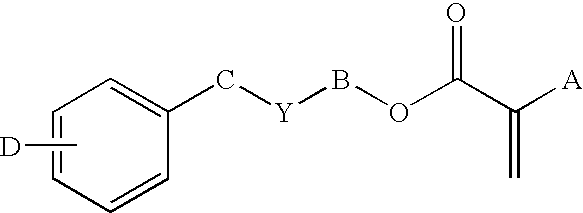Covalently-bound, hydrophilic coating compositions for surgical implants
a technology of surgical implants and compositions, applied in the direction of coatings, transporting and packaging, layered products, etc., can solve the problems of pulling cells off of eye tissues, hydrophobic and/or tacky, and non-hydrogel acrylic materials used in ophthalmic implants
- Summary
- Abstract
- Description
- Claims
- Application Information
AI Technical Summary
Problems solved by technology
Method used
Image
Examples
examples 1-3
Latent Cross-Linking Agent
[0045] The formulations shown in Table 1 below can be prepared and cured in polypropylene slab molds (10 mm×20 mm×0.9 mm). The formulations can be cured by exposure to blue light for one hour using a Kulzer Palatray CU blue light unit (12-14 mW / cm2).
Coating Solution Preparation
[0046] The coating copolymer of Examples 1-4 can be dissolved in a 49:49:2 pbw ethanol:methyl propionate:methylene chloride solvent to give a 6% solution. The resulting solutions can be filtered through a Gelman glass fiber Acrodisc (1 μm) to give particulate-free coating solutions.
Substrate
[0047] A copolymer comprising 65% 2-phenylethyl acrylate; 30% 2-phenylethyl methacrylate; 1.8% o-methyl Tinuvin P; and 3.2% 1,4-butanediol diacrylate can be prepared using 1.8% Perkadox-16 as a thermal initiator. This copolymer, cured in the slab molds described above, extracted in acetone for approximately 2 hours, dried in air at room temperature for about 1 hour, and then dried in an oven...
example 4
Cross-Linking Agent Added when Coating Solution is Formed
[0050] Coated implant slabs are prepared according to the procedure described above for Examples 1-3 except that the coating material contains the ingredients shown in Table 2 below. The coating copolymer is cured using the Kulzer Palatray CU unit for one hour. A coating solution is formed by dissolving the coating copolymer in a 50:50 methyl propionate:ethanol solvent to form an 8.0% solution. The implant slabs are dip coated and allowed to dry in air at room temperature for 15 minutes, followed by baking at 110° C. for 2 hours to de-block the isocyanate cross-linking agent and secure the coating to the implant's surface.
TABLE 2(all amounts in parts by weight)INGREDIENTEx. 42-PEMA32.9APMAM35PEG (400) Monomethylether30Monomethacrylamidedi-Imidazole Blocked 1,12-1.0diisocyanatododecane1-Dodecanethiol0.30Lucirin TPO0.80
PUM
| Property | Measurement | Unit |
|---|---|---|
| water content | aaaaa | aaaaa |
| water content | aaaaa | aaaaa |
| water content | aaaaa | aaaaa |
Abstract
Description
Claims
Application Information
 Login to View More
Login to View More - R&D
- Intellectual Property
- Life Sciences
- Materials
- Tech Scout
- Unparalleled Data Quality
- Higher Quality Content
- 60% Fewer Hallucinations
Browse by: Latest US Patents, China's latest patents, Technical Efficacy Thesaurus, Application Domain, Technology Topic, Popular Technical Reports.
© 2025 PatSnap. All rights reserved.Legal|Privacy policy|Modern Slavery Act Transparency Statement|Sitemap|About US| Contact US: help@patsnap.com



